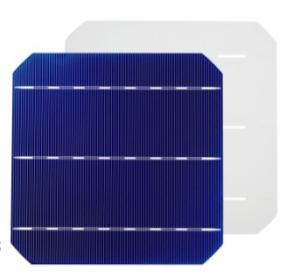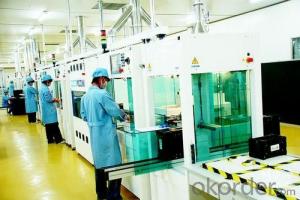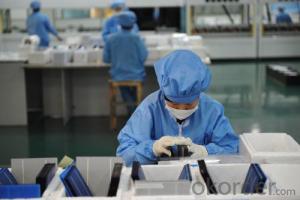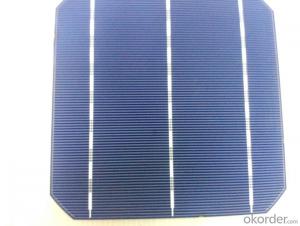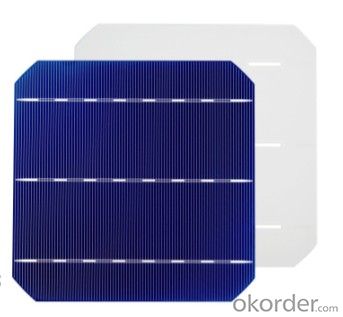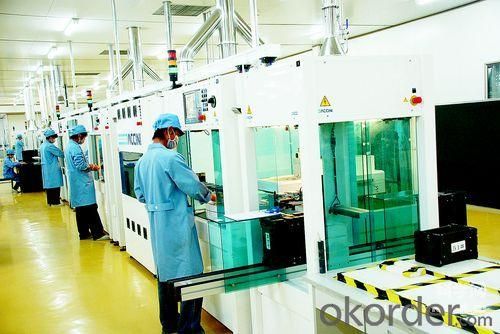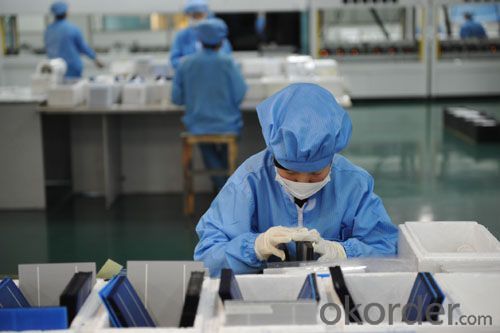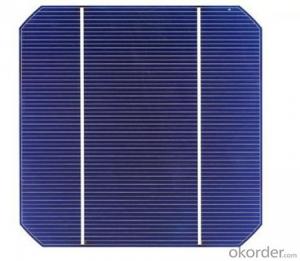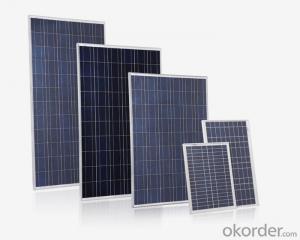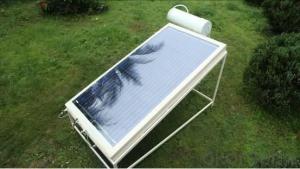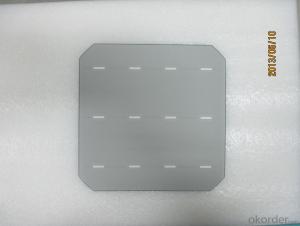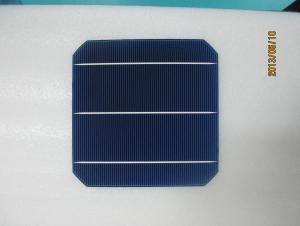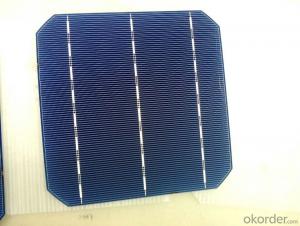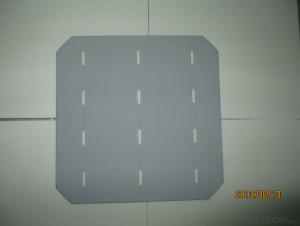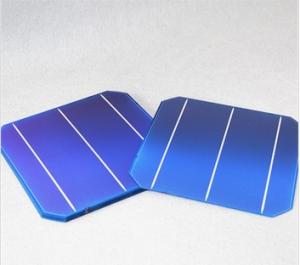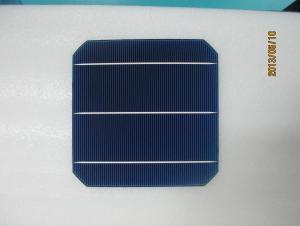156*156mm High Efficiency Fullerene Solar Cells with 4.52 Watt Monocrystal
- Loading Port:
- Shanghai
- Payment Terms:
- TT or LC
- Min Order Qty:
- 1000 pc
- Supply Capability:
- 20000000 pc/month
OKorder Service Pledge
OKorder Financial Service
You Might Also Like
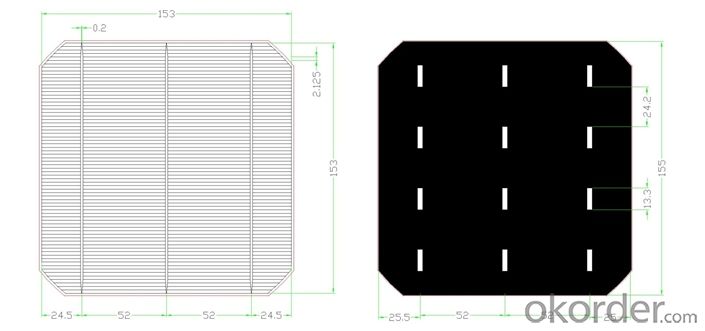
Monocrystal solar energy cell
Type:156M
Appearance:156×1565㎜±0.5mm;diagonal:R=100mm
Main fence wide:1.4-1.5mm back electrode wide:2-2.5mm
Fence line qty:90
Cell thickness:220um±20um
Eff(%) | 18.9- 19.0 | 19.1- 19.1 | 19.1- 19.2 | |||||||||
Pm(W) | 4.52 | 4.54 | 4.56 | |||||||||
Isc(A) | 8.88 | 8.9 | 8.93 | |||||||||
Im(A) | 8.45 | 8.47 | 8.51 | |||||||||
Voc(V) | 0.637 | 0.638 | 0.64 | |||||||||
Vm(V) | 0.536 | 0.537 | 0.538 | |||||||||
FF(%) | 80 | 80 | 80 |

remark:our company cells as per working current concentrate principle,separate the first and the second grade
Advantage of Polycrystalline Solar Cells
Tire-1 Solar Cells’ Manufacturer Quality Guarantee. With a complete and sophisticated quality government system, our Quality Management have arrived world’s leading place. Customer can receive Tire-1 Cells Maker’s Quality Standard Products.
Trusted Warranty. We can supply trusted after-sales service to our customer. If our cells are found not in conformity to the specification of manufacturer, or should the inspected quantity found in shortage, or should the packing found damaged, the buyer has the right to claim to the seller. The claim, if any, should be presented to seller within 30 days after cargo's arrival date to the port, together with related inspection report and photos issued and provided by a reputable independent surveyor such as SGS.
World’s Leading Manufacturer Equipment. We imported the newest and leading production equipment from abroad. Advanced equipment can guarantee the stable quality of cells. Auto production line can also save labor cost which will further cut our production cost.
Factory Picture of Solar Cells
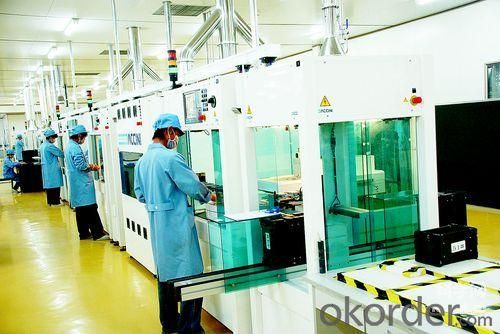
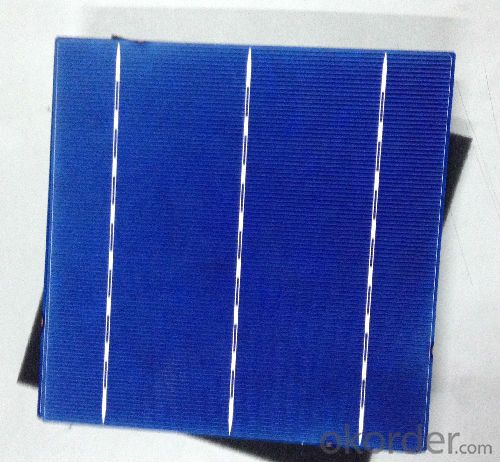
FAQ
We have organized several common questions for our clients,may help you sincerely:
What’s price per watt?
A: It’s depends on the quantity, delivery date and payment terms of the order. We can talk further about the detail price issue. Our products is high quality with lower price level.
Can you tell me the parameter of your solar cells?
We have different series of cells with different power output, both from c-si to a-si. Please take our specification sheet for your reference.
How do you pack your products?
We have rich experience on how to pack the panels to make sure the safety on shipment when it arrives at the destination.
Can you do OEM for us?
Yes, we can.
How long can we receive the product after purchase?
In the purchase of product within three working days, We will arrange the factory delivery as soon as possible. The perfect time of receiving is related to the state and position of customers. Commonly 7 to 10 working days can be served
Concerns of solar cell news
We will see “High efficiency for solar cell” at the major solar cell news. There are some contents about A solar cell made of organic materials has reached record efficiency in converting sunlight into electrical energy. Organic solar cells could be cheaper and more flexible than silicon-based ones, but they are less efficient. To boost efficiency, We also can know some happy news about improving the efficiency of the solar cells .Such as It’s been a roller coaster of a week for the energy markets, so first the good news: a solar research team at Hong Kong Polytechnic University has just laid claim to the highest conversion efficiency yet for solar cells based on perovskites. The new marker is 25.5 percent. The rate was only 3.8 percent in 2009 when researchers around the world began focusing on perovskites, and the prospects look good for even more improvement in the future.
“All-weather solar cell design generates electricity come rain or shine” may be the most attractive solar cell news. In the news ,we can learn lots of things : Amongst graphene's numerous impressive properties is its conductivity, which allows electrons to flow freely across its surface. When placed in an aqueous solution, this gives the material the ability to bind a pair of positively charged ions with a pair of its negatively charged electrons in what is known as a Lewis acid-base reaction. This property is exploited to remove lead ions and organic dyes from solutions and inspired a team led by a scientist to develop solar cells that generate electricity not only from the sun, but also raindrops.
Cheap and flexible should the fashion adjective about solar cells on the solar cell news. In more detail, Polymer solar cells have in recent years emerged as a low cost alternative to silicon solar cells. In order to obtain high efficiency, fullerenes are usually required in polymer solar cells to separate charge carriers. However, fullerenes are unstable under illumination, and form large crystals at high temperatures.
Now, a team of chemists led by Professor Jianhui Hou at the CAS set a new world record for fullerene-free polymer solar cells by developing a unique combination of a polymer called PBDB-T and a small molecule called ITIC. With this combination, the sun's energy is converted with an efficiency of 11%, a value that strikes most solar cells with fullerenes, and all without fullerenes. So ,we deal with those problems well .
- Q: What is the impact of solar cells on reducing energy waste?
- Solar cells have a significant impact on reducing energy waste as they harness clean and renewable energy from the sun, thus reducing the need for fossil fuels. By converting sunlight into electricity, solar cells provide a sustainable and environmentally friendly alternative, reducing greenhouse gas emissions and dependence on non-renewable energy sources. This helps combat climate change and promotes a more efficient use of energy, ultimately decreasing energy waste.
- Q: Can solar cells be used for powering transportation infrastructure?
- Yes, solar cells can be used for powering transportation infrastructure. Solar-powered electric vehicles, such as solar cars, solar buses, and solar trains, are already being developed and deployed in various parts of the world. Additionally, solar energy can also be used to provide power for charging stations and electric vehicle infrastructure, reducing reliance on traditional energy sources and promoting sustainability in transportation.
- Q: What is a monocrystalline Silicon Solar Cells?
- Monocrystalline photovoltaic electric solar energy panels have been the go-to choice for many years. They are among the oldest, most efficient and most dependable ways to produce electricity from the sun.
- Q: How to define the poly solar cells as the A Grade one?
- It is hard to tell if the poly solar cells you bought has no certificate, ganratees.
- Q: Where and how can I find more information of Photovoltaic Cells Solar Panels? Can anybody share more about that?
- Photovoltaic cells produce electricity directly from sunlight. Photovoltaic cells are also called PV cells or solar cells. Many PV cells are used in remote locations not connected to the electric grid. Photovoltaic cells comprise the main component in solar panels and are also used to power watches, calculators, solar lights, and lighted road signs.
- Q: What is 3d solar cell? And anybody know any manufacturers?
- 3d solar cell is 3-dimensional silicon solar cell, which is is designed to maximize the conversion of sunlight into electricity.
- Q: Can solar cells be used for powering desalination plants?
- Yes, solar cells can be used for powering desalination plants. Solar energy can be harnessed through photovoltaic panels, which convert sunlight into electricity. This electricity can then be used to power the desalination process, where saltwater is converted into freshwater through various methods such as reverse osmosis or distillation. Utilizing solar cells for powering desalination plants offers a sustainable and renewable energy source, reducing reliance on fossil fuels and minimizing the environmental impact of the desalination process.
- Q: How are solar cells used in military applications?
- Solar cells are used in military applications to power portable electronic devices, remote surveillance systems, and even to provide electricity to military bases in remote locations. They offer a reliable and sustainable source of power, reducing the need for fuel resupply and minimizing the environmental impact. Additionally, solar cells can be integrated into various military equipment, such as backpacks and helmets, enabling soldiers to generate power on the move.
- Q: Can solar cells be used for powering remote sensing devices?
- Yes, solar cells can be used for powering remote sensing devices. Solar cells convert sunlight directly into electricity, making them an ideal renewable energy source for remote areas or devices that require continuous power supply. Solar-powered remote sensing devices are commonly used in environmental monitoring, agriculture, and wildlife research, among other applications.
- Q: Can solar cells be used underwater?
- No, solar cells cannot be used underwater as they rely on sunlight to generate electricity. Water blocks sunlight and prevents the solar cells from functioning effectively.
Send your message to us
156*156mm High Efficiency Fullerene Solar Cells with 4.52 Watt Monocrystal
- Loading Port:
- Shanghai
- Payment Terms:
- TT or LC
- Min Order Qty:
- 1000 pc
- Supply Capability:
- 20000000 pc/month
OKorder Service Pledge
OKorder Financial Service
Similar products
Hot products
Hot Searches
Related keywords
